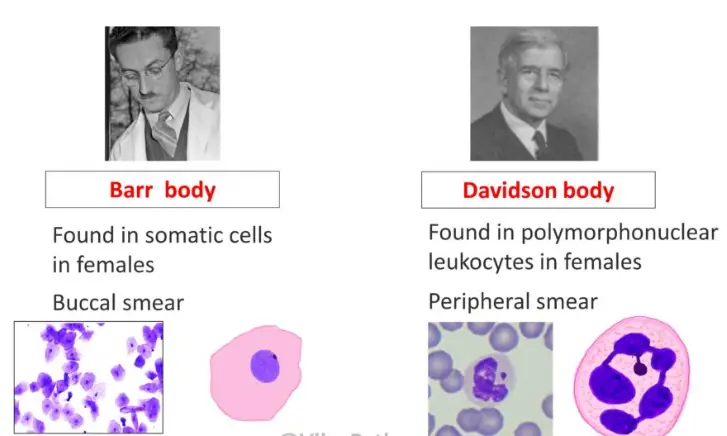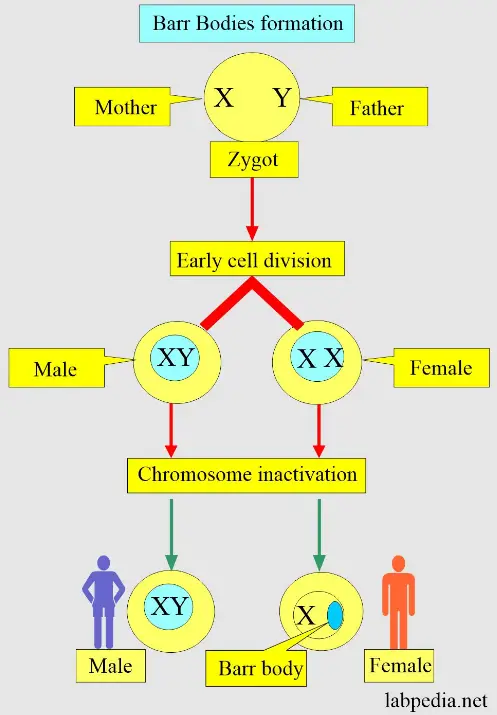Cells contain numerous structures, each with specific functions that contribute to the life processes of organisms. Among these, chromatin structures like the Barr Body and Davidson Body play crucial roles in genetic expression and regulation. These elements are not only pivotal in understanding cellular function but also in diagnosing certain genetic conditions.
The Barr Body and Davidson Body are cellular components identified by their unique formation and roles within the cell. The Barr Body, typically found in female mammals, is an inactivated X chromosome visible in certain cells, playing a key role in X-chromosome inactivation. The Davidson Body, on the other hand, is less well-understood and is characterized by its presence under specific staining conditions, suggesting a distinct functional role in cellular biology.
While the Barr Body is associated with the phenomenon of dosage compensation in females, the Davidson Body’s function remains more obscure, highlighting the diversity and complexity of cellular components. Their study provides valuable insights into genetic regulation mechanisms and their implications in health and disease, making them essential topics in medical genetics.

Barr Body Basics
Definition of Barr Body
A Barr Body is an inactivated, condensed X chromosome found within the nuclei of somatic cells, primarily in female mammals. This structure is named after Murray Barr, who first described it in 1949. Visible under a microscope as a dense, darkly staining spot within the nucleus, the Barr Body is a key player in the genetic regulation process known as X-chromosome inactivation (XCI).
Formation Process
The formation of the Barr Body involves several steps:
- X-Chromosome Pairing: Early in development, the two X chromosomes in a female come close together.
- Choice of Inactivation: One X chromosome is randomly chosen to be inactivated in each cell.
- Initiation of Inactivation: The inactivation begins at the X-inactivation center (Xic) on the X chromosome.
- Spread of Inactivation: The inactivation spreads along the X chromosome, compacting it into heterochromatin.
- Maintenance: Once established, the inactivated state is maintained throughout the life of the cell.
Biological Significance
The Barr Body is critical for dosage compensation—the process by which cells equalize the expression of genes between males (XY) and females (XX) to prevent overexpression in females. This mechanism is vital for normal development and functioning. Disruptions in Barr Body formation can lead to developmental abnormalities and are associated with several genetic disorders.
Davidson Body Essentials
Definition of Davidson Body
The Davidson Body is a lesser-known chromatin body identified by unique staining properties. While not as widely studied or understood as the Barr Body, it represents another aspect of chromatin behavior within the nucleus.
How it Forms
The formation process of the Davidson Body is not as well characterized as that of the Barr Body. It is believed to form under specific conditions that are not fully defined but include unique environmental or cellular states that trigger its appearance in the nucleus.
Role in Cells
The exact role of the Davidson Body in cells remains an area of ongoing research. Preliminary findings suggest that it may be involved in specific regulatory functions or in response to cellular stress conditions. Its identification and study could lead to new insights into chromosome biology.
Comparative Analysis
Structural Differences
While both the Barr Body and Davidson Body are compact structures within the nucleus, they differ significantly in appearance and consistency:
- Barr Body: Typically appears as a singular, dense mass.
- Davidson Body: Often exhibits a more fragmented or less dense structure.
Functional Contrasts
The functional roles of these bodies also diverge:
- Barr Body: Primarily involved in dosage compensation and genetic stability.
- Davidson Body: Potentially plays a role in response to environmental or cellular stress, although this is less clear.
Genetic Implications
The study of these chromatin bodies has profound implications for genetics:
- Barr Body: Helps in understanding X-linked genetic disorders and the mechanisms of X chromosome inactivation.
- Davidson Body: Could uncover new layers of chromosomal regulation and response mechanisms within the cell.

Visualization Techniques
Chromosome Staining
Chromosome staining is a fundamental technique in genetics, allowing researchers to visualize structures like the Barr Body and Davidson Body under a microscope. The most common method used is the Giemsa stain, which binds to the phosphate groups of DNA, creating a distinct pattern that highlights chromosomal features.
Steps for Giemsa Staining:
- Fixation: Cells are first fixed to preserve their structure.
- Permeabilization: Treatment with a mild detergent to allow entry of the dye.
- Staining: Application of Giemsa stain which adheres to the DNA.
- Rinsing: Excess stain is washed away, leaving a clear image of the chromosomes.
This technique not only helps in identifying chromosomal abnormalities but also provides a clear view of inactivated X chromosomes in female cells.
Microscopy Methods
Microscopy has advanced significantly, providing detailed images of cellular components. The key techniques include:
- Fluorescence Microscopy: Uses high-intensity light to excite fluorescent molecules in a sample. It is particularly useful for observing stained chromosomes and can differentiate between active and inactive chromosomal regions.
- Confocal Microscopy: Offers higher resolution by eliminating out-of-focus light, ideal for detailed structural analysis of chromosome compactness and positioning within the nucleus.
- Electron Microscopy: Provides the highest resolution by using a beam of electrons instead of light, allowing for the visualization of the ultrastructure of chromatin bodies.
Image Analysis
Modern image analysis techniques enhance the data obtained from microscopy, using software tools to quantify and analyze the morphology and intensity of stained chromosomes. This includes measuring the size and shape of chromatin bodies, comparing staining patterns across different cell types, and automating the detection of genetic abnormalities.
Relevance in Medical Science
Genetic Disorders Identification
The visualization techniques discussed are crucial in identifying genetic disorders, particularly those related to abnormalities in chromosome number or structure. For example, the presence of an additional Barr Body may indicate Klinefelter Syndrome (XXY), while the lack of a Barr Body could be indicative of Turner Syndrome (XO).
Gender Verification Testing
In sports and other fields, chromosomal analysis, including the identification of Barr Bodies, plays a role in gender verification testing. This can be controversial but is used to ensure fairness in gender-restricted competitions. The techniques outlined help accurately determine the chromosomal makeup of an individual.
Research Applications
Beyond medical diagnostics, these visualization techniques are pivotal in research applications, including:
- Developmental Biology: Understanding how chromosome inactivation is regulated during development.
- Cancer Research: Analyzing tumor cells for chromosomal changes that could indicate cancer progression or susceptibility.
- Genetic Engineering: Assisting in the creation of genetically modified organisms by providing detailed chromosomal maps.
FAQs About Barr and Davidson Bodies
What is a Barr Body?
A Barr Body is a condensed, inactivated X chromosome found in the nuclei of somatic cells in female mammals. This formation ensures dosage compensation by equalizing gene expression between males (XY) and females (XX).
How is a Davidson Body identified?
The Davidson Body can be identified through specific staining techniques that highlight its unique structure within the nucleus. It is less commonly discussed than the Barr Body and appears under less well-defined biological conditions.
Why are Barr Bodies important in genetics?
Barr Bodies are crucial for understanding genetic diseases and conditions linked to X chromosome genes. Their study helps in diagnosing disorders such as Klinefelter syndrome and Turner syndrome, where the number of X chromosomes doesn’t follow typical patterns.
Can males have a Barr Body?
Typically, males do not have a Barr Body because they possess only one X chromosome. However, in genetic conditions like Klinefelter’s syndrome (XXY), males can have a Barr Body.
Conclusion
The exploration of cellular components like the Barr Body and Davidson Body provides critical insights into the mechanisms of genetic regulation and their implications in both health and disease. This understanding not only advances scientific knowledge but also supports the development of targeted genetic therapies and diagnostics.
Future research into these cellular structures will likely uncover even more about their roles and potential in medical science. As we continue to unravel the complexities of the cell, the implications for genetic research and medical applications remain vast and compelling.

